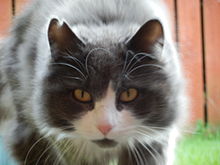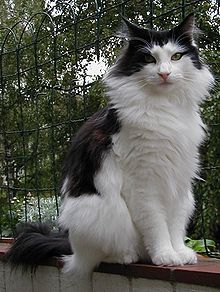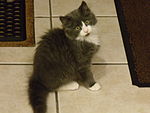- Norwegian Forest Cat
-
Norwegian Forest Cat 
A genuine Norwegian Forest Cat in Norway Alternative names Skogkatt / Skaukatt
Norsk Skogkatt / Norsk SkaukattOrigin Norway Common nicknames Weegie Breed standard FIFe standard CFA standard TICA standard AACE standard ACFA standard ACF standard CCA standard Cat (Felis catus) The Norwegian Forest Cat is a breed of domestic cat native to Northern Europe, and adapted to a very cold climate, with top coat of glossy, long, water-shedding hairs, and a woolly undercoat for insulation. Although this is uncertain, the breed's ancestors may have been short-haired cats brought to Norway by the Vikings around 1000 AD, and may also have included the long-haired Siberian and Turkish Angora. During World War II, the breed became nearly extinct until efforts by the Norwegian Forest Cat Club helped the breed by creating an official breeding program. It was not registered as a breed with the European Fédération Internationale Féline until the 1970s, when a local cat fancier, Carl-Fredrik Nordane, took notice of the breed and made efforts to register it. Currently, the Norwegian Forest Cat is very popular in Norway, Sweden, and France.
It is a strong, big cat, similar to the Maine Coon breed, with long legs, a bushy tail, and a sturdy body. The breed is very good at climbing, since they have strong claws. The lifespan is usually 14 to 16 years, though kidney and heart diseases have been reported in the breed. Specifically in this breed, complex rearrangements of glycogen branching enzyme (GBE1) can cause a perinatal hypoglycemic collapse and a late-juvenile-onset neuromuscular degeneration in glycogen storage disease type IV.
Contents
History
The Norwegian Forest Cat comes from natural selection to survive Norway's cold weather.[1][2] Its ancestors may include black and white shorthair cats brought to Norway from Great Britain sometime after 1000 AD by the Vikings and longhaired cats brought to Norway by Crusaders. These cats would reproduce with farm and feral stock and would eventually evolve into the modern-day Norwegian Forest Cat.[3][4][5] The Siberian and the Turkish Angora, longhaired cats from Russia and Turkey, respectively, are also possible ancestors of the breed.[3] Norse legends refer to the Skogkatt as a "mountain-dwelling fairy cat with an ability to climb sheer rock faces that other cats could not manage."[6] Since the Norwegian Forest Cat is the most adept climber,[7] author Claire Bessant believes that the Skogkatt could be about the Norwegian Forest Cat.[6]
Many people believe that the ancestors of the Norwegian Forest Cat served as mousers on Viking ships. They lived in the Norwegian forests for many centuries, but were later prized for their hunting skills and were used on Norwegian farms.[8] Norwegian Forest Cats would continue acting as mousers at Norwegian farms until they were discovered in the early twentieth century by cat enthusiasts.[9]
In 1938, the first Norwegian Forest Cat Club was formed. The club's movement to preserve the breed was interrupted by World War II (WWII). Due to cross-breeding with free-ranging domestic cats during WWII, the Norwegian Forest Cat became endangered and nearly extinct until the Norwegian Forest Cat Club helped the breed make a comeback by developing an official breeding program.[8][10][11] Since the cat did not leave Norway until the 1970s, it was not registered as a breed in the Fédération Internationale Féline, a European federation of cat registries, until Carl-Fredrik Nordane, a local cat fancier, took notice of the breed, and made efforts to register it. The breed was registered in Europe by the 1970s, but was not recognized by the American Cat Fanciers Association until 1994.[12] In 1978, it was recognized in Sweden,[13] and in 1989, they were accepted as a breed in the United Kingdom.[14] The Norwegian Forest Cat is very popular in Norway and Sweden. It is the fifth most popular breed in France since 2003, where there are about 400 to 500 births per year.[15][16][17]
Breed description
The Norwegian Forest Cat is strongly built and is similar in size to the Maine Coon. The breed has a long, sturdy body, long legs, and a bushy and full tail. The coat consists of a long, glossy, thick and water-repellant top layer, and a woolly undercoat, and is thickest at the legs, chest, and head.[6] The profile of the breed is generally straight.
The head is long, with an over-all shape similar to an equilateral triangle, a strong chin, and a muzzle of medium length; a square or round-shaped head is considered to be a defect.[18] The eyes are almond shaped and oblique, and may be of any colour.[6][19] The ears are large, wide at the base, high set, have a tufted top, are placed in the extension of the triangle formed by the head, and end with a tuft of hair like the ears of the lynx.[18] All coat colors are accepted except chocolate and lilac and the dilutions fawn and cinnamon.[18] Since the cats have very strong claws, they are very good climbers, and can even climb rocks.[12]
Norwegian Forest cats have a quiet voice but can develop a loud voice if kept in a house with a dog. [6] Moreover, they are generally talkative unless raised with a dog, then they are seemingly shy.[citation needed] They are friendly and intelligent and are good with people,[3]. The Norwegian Forest cat has a high amount of energy [3] and can be very demanding of attention. Those cats that live primarily outdoors become swift and effective hunters, but the breed can also adapt to indoor life.[5] If bought from a registered breeder, they tend to cost from $550 to $800. The cats usually live to be 14 to 16 years old.[20] As they are heavy-boned and tall they require more food than most other domestic breeds.[4][20] Males are considerably heavier and larger-boned than females.[21]
Health issues
There have been kidney and heart diseases reported in the breed.[20] In an experiment directed by John C. Fyfea, Rebeccah L. Kurzhals, and others, it was concluded that a complex rearrangement in the breed's Glycogen branching enzyme (GBE1) can cause both a perinatal hypoglycemic collapse and a late-juvenile-onset neuromuscular degeneration in glycogen storage disease type IV in the breed.[22][23] This disorder, while rare, can prove fatal to cats that have it.[3] There are DNA test available for GSD IV, it is highly recommended (some cat associations obligate their Norwegian forest cat breeder member) to carry out the DNA test before using such animal for breeding. PawPeds provide pedigree data base which come together with health programmes, through publishing each single cat's test result, to provide useful information for breeders who aim to breed healthy cat make a well informed breeding decision. The breed has also been known to suffer from hip dysplasia,[24] which is a rare, partially hereditary disease of the hip joint.[25] The breed, along with several other cat breeds, can be poisoned by things that are considered safe to humans, including alcoholic beverages, avocados, all forms of chocolate and coffee, macadamia nuts, onions, raisins, grapes, salt, and garlic.[26] The breed is, along with most other cats, known to run the risk of getting Feline viral rhinotracheitis,[27] Feline immunodeficiency virus,[28] Rabies,[29] H5N1,[30] or several other diseases.[31]





1 day 1 week 3 months 8 months less than a year 18 months See also
- Siberian cat
- Maine coon (this breed is also considered a forest cat)
- Dewey Readmore Books, probably a Norwegian forest cat
References
- ^ "Accueil - chat norvegien - chat des forets norvegiennes" (in French). Kogkatt-norvegien.org. http://skogkatt-norvegien.org/entree.php. Retrieved 2011-03-05. "D'un aspect mi-chat, mi-lynx. Contrairement à d'autres races, le "Norvégien" n'est pas le résultat d'une reproduction planifiée mais la conséquence de l'évolution d'un chat placé dans des conditions de survie particulièrement difficiles: le rigoureux climat de la Norvège."
- ^ Rousselet-Blanc, Pie (1992). Encyclopedie Active Le Cha. Larousse Kingfisher Chambers. p. 174. ISBN 2035174023.
- ^ a b c d e Richards, James (1999). ASPCA Complete Guide to Cats: Everything You Need to Know About Choosing and Caring for Your Pet. San Francisco: Chronicle Books. pp. 128–129. ISBN 9780811819299.
- ^ a b Case, Linda (2003). The Cat: Its Behavior, Nutrition and Health (1 ed.). Ames, Iowa: Wiley-Blackwell. p. 26. ISBN 9780813803319.
- ^ a b Taylor, David (1989). Ultimate Cat Book: A Unique Photographic Guide to More Than 100 International Breeds and Variations (1 ed.). New York City: Simon & Schuster. pp. 76–77. ISBN 9780671686499.
- ^ a b c d e Bessant, Claire; Cutts, Paddy (1999). The Complete Guide to the Cat (Complete Animal Guides) (1 (US & CA) ed.). Hauppauge, New York: Barron's Educational Series. p. 181. ISBN 9780764152030.
- ^ Caravan, Jill (1998). An Identification Guide to Cat Breeds. Hertfordshire: Eagle Editions. pp. 88–89. ISBN 9781902328003.
- ^ a b Furstinger, Nancy (2005). Norwegian Forest Cats. Edina, Minnesota: Abdo Publishing. p. 6. ISBN 9781596792678.
- ^ Duno, Steve (2008). Be the Cat: Secrets of the Natural Cat Owner. New York City: Sterling Publishing. p. 22. ISBN 9781402752780.
- ^ Richards, Dorothy Silkstone (1996). Cat: Selection, Care, Training, Nutrition, Health, Breeding, Showing (2 ed.). London: Salamander Books. p. 56. ISBN 9780861017034.
- ^ Carolyn M. Vella, Lorraine M. Shelton, John J. McGonagle, Terry W. Stanglein (1999) (Hardcover). Robinson's Genetics for Cat Breeders and Veterinarians (4th ed. ed.). Oxford: Butterworth–Heinemann. pp. xi-xii. ISBN 9780750640695.
- ^ a b Kristen Hampshire, Iris Bass, Lori Paximadis (2009). Cat Lover's Daily Companion: 365 Days of Insight and Guidance for Living a Joyful Life with Your Cat (1 ed.). Beverly, Mass.: Quarry Books. ISBN 9781592535910. ASIN 1592535917.
- ^ "Kattförbundet Sverak" (in French). Sverak. Retrieved 2011-03-20.
- ^ McGreevy, Paul (2002) (Hardcover). Cats (Home Reference Library). San Francisco: Fog City Press. p. 249. ISBN 9781876778750.
- ^ "Pour l'Angleterre" (in French). Aniwa.com. http://archive.wikiwix.com/cache/?url=http://www.aniwa.com/fr/chat/document/fr/chat/magazine/tendances/le-chat-de-race-en-angleterre---les-grandes-evolutions/index.htm&title=pour%20l'Angleterre. Retrieved 2011-03-05.
- ^ "Le Sphynx : Haut dans les cœurs du classement CFA" (in French). Aniwa. Retrieved 2010-12-06.
- ^ "Bienvenue sur le site de l'Unité de Médecine de l'Elevage et du Sport de l'Ecole Nationale Vétérinaire d'Alfort". (in French). UMES. Retrieved 2011-03-12
- ^ a b c Rousselet-Blanc, Pie (1992). Hardcover. ed (in French). Encyclopedie Active Le Chat. New York City: Larousse Kingfisher Chambers. p. 175. ISBN 9782035174024.
- ^ Norwegian Forest Breed Standard. The International Cat Association. Published 1 May 2004. Accessed 26 March 2011.
- ^ a b c Burke, Don (2005). The Complete Burke's Backyard: The Ultimate Book of Fact Sheets. Millers Point, N.S.W.: Murdoch Books. p. 723. ISBN 1740457390.
- ^ Stephens, Gloria (2001). Legacy of the Cat. San Francisco: Chronicle Books. pp. 112–113. ISBN 9780811829106. ASIN 0811829103.
- ^ Fyfe, John C.; Kurzhals, Rebeccah L.; Hawkins, Michelle G.; Wang, Ping; Yuhki, Naoya; Giger, Urs; Van Winkle, Thomas J.; Haskins, Mark E. et al. (2007). "A complex rearrangement in GBE1 causes both perinatal hypoglycemic collapse and late-juvenile-onset neuromuscular degeneration in glycogen storage disease type IV of Norwegian forest cats". Molecular Genetics and Metabolism 90 (4): 383–392. doi:10.1016/j.ymgme.2006.12.003. PMC 2063609. PMID 17257876. http://www.pubmedcentral.nih.gov/articlerender.fcgi?tool=pmcentrez&artid=2063609. "Deficiency of glycogen branching enzyme (GBE) activity causes glycogen storage disease type IV (GSD IV), an autosomal recessive error of metabolism. Abnormal glycogen accumulates in myocytes, hepatocytes, and neurons, causing variably progressive, benign to lethal organ dysfunctions. A naturally occurring orthologue of human GSD IV was described previously in Norwegian forest cats (NFC)."
- ^ Eldredge, Debra; Carlson, Delbert DVM; Carlson, Liisa; Giffin, James (Hardcover). Cat Owner's Home Veterinary Handbook, Fully Revised and Updated (3rd ed.). Howell Book House. p. 403. ISBN 9780470095300.
- ^ Eldredge, Debra (2003). "17: Preventative Health Care for Your Pet" (Paperback). Pills For Pets: The A to Z Guide to Drugs and Medications for Your Animal Companion. Citadel Press. p. 63. ISBN 9780806524368. "An example here is the Norwegian forest cat. Dedicated owners learned that their cats have the possibility of suffering from hip dysplasia."
- ^ Simon, John; Pederson, Stephanie (2000) (Mass Market Paperback). What Your Cat Is Trying To Tell You (1st ed.). St. Martin's Press. p. 168. ISBN 9780312972882.
- ^ "Toxic to Cats". Vetinfo.com. http://www.vetinfo.com/ctoxin.html. Retrieved 2011-03-27.
- ^ Ettinger, Stephen J.;Feldman, Edward C. (1995). Textbook of Veterinary Internal Medicine (4th ed.). W.B. Saunders Company. ISBN 0-7216-6795-3.
- ^ Valéria Maria Lara, Sueli Akemi Taniwaki, João Pessoa Araújo Júnior (2008), "Occurrence of feline immunodeficiency virus infection in cats", Ciência Rural 38 (8), doi:10.1590/S0103-84782008000800024, http://www.scielo.br/scielo.php?script=sci_arttext&pid=S0103-84782008000800024.
- ^ George, Baer (1991) (Hardcover). The Natural History of Rabies (2nd ed.). CRC Press. p. 380. ISBN 9780849367601.
- ^ Parker, Tara (2009-11-05). "Parker-Pope, Tara. November 5, 2009 "The Cat Who Got Swine Flu." ''New York Times.''". Well.blogs.nytimes.com. http://well.blogs.nytimes.com/2009/11/05/the-cat-who-got-swine-flu/. Retrieved 2010-04-05.
- ^ Greene, Craig (2006) (Hardcover). Infectious Diseases of the Dog and Cat, Revised Reprint (3rd ed.). Saunders. pp. 1-1440. ISBN 9781416036005.
Further reading
- Darlene, Arden (2011). The Complete Cat's Meow: Everything You Need to Know about Caring for Your Cat (1st ed.). Hoboken, New Jersey: John Wiley & Sons. ISBN 9780470641675.
- Douglas, Mary-Rose (1999). Cats from the Scandinavian Woods: A Study of Norwegian Forest Cats. Huntingdon, England: Just print IT!. ISBN 9781902869056.
- Kizelbakh, D. (2009). Norwegian Forest Cat / Norvezhskaya lesnaya koshka. Moscow: Akvarium-Print. ISBN 9785993402307.
- Walton, J.A. (1999). Notes for Novice Breeders: Norwegian Forest Cats. Huntingdon, England: Just Print IT!. ISBN 9781902869032.
External links
- Norsk Skogkatt Society, UK
- Norwegian Forest Cat Club, UK
- Viking Cat Club, UK
- Cat Fanciers' Association Breed Profile: Norwegian Forest Cat
- PawPeds Norwegian forest cat data base
- PawPeds health program - GSD IV, HCM
Categories:- Cat breeds
- Animal breeds originating in Norway
Wikimedia Foundation. 2010.



